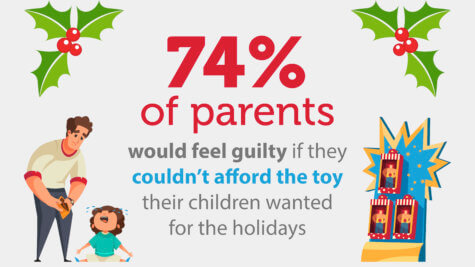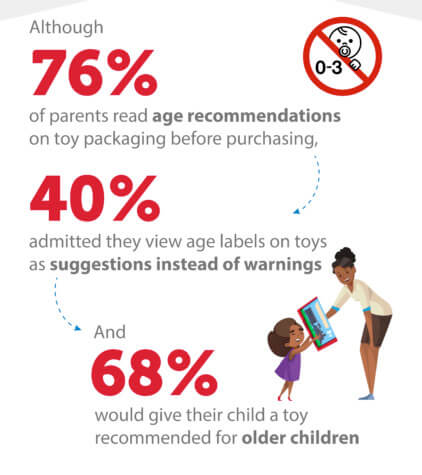NEW YORK — When the holidays arrive, a new study finds parents are trying to “deck the halls” — at all costs. Four in five parents are feeling pressure to make this holiday season the most memorable one for their children.
A study of 2,000 parents of children under 12 found that parents plan on making this holiday season memorable by keeping holiday traditions like decorating, baking, spending time with their loved ones, and by buying plenty of gifts.
Holiday shopping for kids is no walk in the park
 One in six parents always struggle to find something their child would want as a gift. That’s why one in seven respondents begin holiday shopping as early as September. Sixty-two percent of those who celebrate the holidays feel they spend too much time on gift shopping, with a quarter of parents saying they take at least a week to complete their holiday shopping for their children (27%).
One in six parents always struggle to find something their child would want as a gift. That’s why one in seven respondents begin holiday shopping as early as September. Sixty-two percent of those who celebrate the holidays feel they spend too much time on gift shopping, with a quarter of parents saying they take at least a week to complete their holiday shopping for their children (27%).
The pressure is on for 41 percent of parents who say their kids would feel disappointed if they don’t get the gift they want. The top gifts kids want for the holidays are toys (62%) and electronics (58%).
Conducted by OnePoll on behalf of The Toy Association, the survey showed parents are also upping their research game to find the best toys for their children. That includes reading online reviews (47%) or learning about them from child influencers on social media (45%).
Even when parents know what to get, other roadblocks get in their way
Over half the poll (53%) struggle with getting their hands on items their kids want, leading 65 percent to purchase knock-off or counterfeit toys if their first choice is unavailable. Six in 10 admit that holiday shopping for their kids gets too expensive, yet nearly three-quarters would feel guilty if they couldn’t afford the toy on their children’s wish list (74%).
 That’s why 63 percent of parents admit they would opt for the counterfeit version if it’s cheaper than the original. More than half of parents have previously and knowingly purchased a knock-off toy for their child (54%). Although two in three would feel guilty about buying a counterfeit version of the toy their child wanted, 44 percent would consider that option anyway.
That’s why 63 percent of parents admit they would opt for the counterfeit version if it’s cheaper than the original. More than half of parents have previously and knowingly purchased a knock-off toy for their child (54%). Although two in three would feel guilty about buying a counterfeit version of the toy their child wanted, 44 percent would consider that option anyway.
Parents are not strangers to counterfeit toys, as 74 percent know that third-party sellers sell them on popular online marketplaces. However, the data also showed that one in 10 parents are unaware that counterfeit toys can be dangerous for kids to play with.
“Illicit sellers of counterfeit toys dupe parents into thinking they are buying the real thing, or entice them with lower prices or the promise of getting the ‘hot toy’ of the holiday season,” says Joan Lawrence, senior vice president of standards and regulatory affairs at The Toy Association, in a statement.
“What’s scary is that these illegitimate sellers are actually peddling fake and unsafe products which often do not comply with product safety laws. That is why we always urge parents to shop from reputable brands and sellers whose toys have been tested for compliance with over 100 different safety standards and tests required by law.”
Knock off the knock-offs
Generally, 73 percent of parents prefer purchasing products from reputable brands because of their quality (84%) or their variety (48%). Before putting the items in their shopping carts, three-quarters of parents (76%) say they make sure they thoroughly read age recommendations on the packaging or in online descriptions.
However, 40 percent of respondents admit they view age labels on toys as suggestions instead of legitimate warnings. Nearly seven in 10 would give their child a toy recommended for older children (68%) because they think they’re mature enough to play with a “more challenging toy” and think it’s safe since they always keep an eye on them.
“Age labels on toys are not suggestions – they are established by experts who take a multitude of factors into account to ensure children’s safety,” Lawrence adds.
“Legitimate toymakers and retailers work year-round to ensure the safety of the products they offer families. Likewise, parents and caregivers are encouraged to buy age-appropriate toys for their children and to avoid purchasing counterfeits. If a deal on a ‘hot’ toy looks too good to be true, it probably is. Buy the real thing or wait for a trusted retailer to restock the product – buying a fake toy or cheaper alternative is just not worth the risk.”
